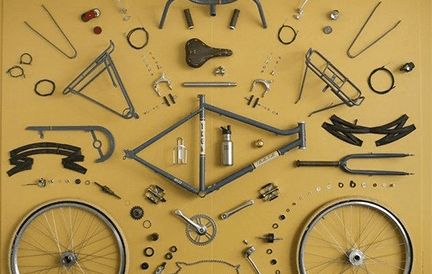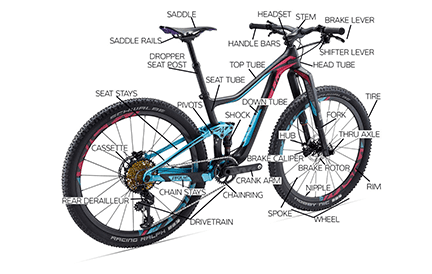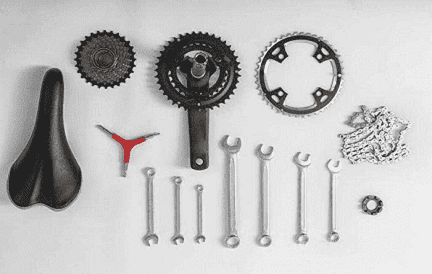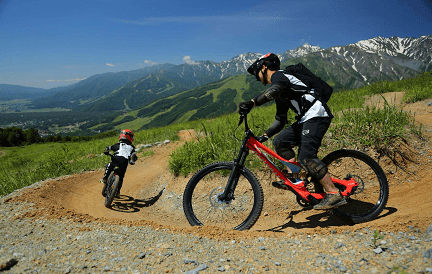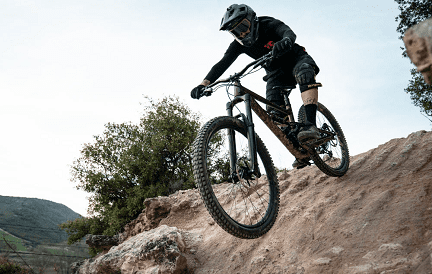MTB forks are an important part of mountain biking. They can affect the way you ride and where you ride. The MTB forks are the part of the bike that steers the bike, on which the front wheel of the bike is mounted. A MTB fork typically has two blades which are joined at the top by the fork crown. Fork parts MTB consists of the steerer tube, fork legs, brake mounts, and dropout for the wheeling axle.
- Part 1: The Different Types of MTB Forks
- Part 2: Comparison Between Rigid Forks and Suspension Forks
- Part 3: Knowing What Forks Fits Your Mountain Bike
Part 1: The Different Types of MTB Forks
The different types of MTB Forks are rigid forks and suspension forks.
Rigid MTB Forks
Rigid forks have no suspensions and have been in existence as far back as the creation of mountain bikes. Rigid forks still hold a great deal of appeal to many mountain bike riders because of their many benefits. It can help improve riding skills because it gives more predictable steering and does not compress the underload, it requires no servicing or maintenance.
How to Choose Rigid Forks For Mountain Bikes
Rigid forks are fixed, they do not compress or alter in size, they are more practical, and do not absorb the roughness of the terrain. This does not mean you are subjected to absolute punishment. If you live in an area with very smooth trails, and wide-open terrain, rigid forks can also provide unique riding experiences.
And like every mountain bike part, there are several factors to consider when choosing rigid forks for your mountain bike like the material the fork is made from and its size.
The materials rigid forks are made of include; steel and carbon.
Steel – steel has been the traditional material of choice for rigid forks because it is durable and allows an amount of elasticity. Steel can survive a lot of vibration cycles and impacts without failing. But, one of the disadvantages of steel forks is they are heavy.
Carbon-rigid forks made from carbon are expensive, almost as expensive as suspension forks. They can dampen trail chatter and absorb vibrations excellently.
The Size of the Rigid MTB Forks
Another factor to consider when choosing rigid forks is their size. Their fixed height, axle to crown is important.
Each mountain bike wheel requires a specific size of fork. You need to know the specific wheel size your bike offers. If you have 29in wheels, you need a corresponding fork size. Choose a fork with dropouts that matches the type of axle used in your front wheel. Your headtube diameter is also important, the diameter of your frame head tube will determine the diameter of your forks steerer tubes.
Pros And Cons of Rigid MTB Forks
Here are the pros and cons of rigid forks
Pros
1. It is long lasting.
Rigid forks are strong enough to withstand pressure without damage.
2. Requires no maintenance
Rigid forks are simple and require little or no maintenance.
3. It is much lighter than a suspension fork
Rigid forks are much lighter, there is no added weight because there are no shocks. This lightness is an advantage because added weight reduces speed.
4. Increased bar sensitivity
With rigid forks, there is an increased bar sensitivity that will make you more in tune with the trail. Some say it improves your bike handling skills.
Cons
1. Unsuitable for rough terrains
Riding rigid forks in rough terrains is unsuitable and uncomfortable because of the lack of shock absorbers, your wrists and arms take on the hit of the terrain. It can be quite uncomfortable because of the rattling, you will feel every bump and shake while riding.
Suspension MTB Forks
There are two types of spring, the air spring, and the coil spring. Air spring is the more popular spring type on expensive forks. The air spring is lightweight and contains tuning ability. Air spring volume is adjustable in some models and with a shock pump, you can set the air spring resistance to whatever you are looking for on the fly. Although, they don’t provide the sensitivity and performance of coil springs.
Coil springs however are a metal corkscrew coil that provides resistance, they provide a really sensitive trail feeling and are heavier than air springs. Coils springs have a lesser adjustment range and can be found on lower-end models of mountain bikes. They are commonly used for enduro and heavy-duty mountain bikes because they absorb heat better.
Mountain bikes suspension forks come in two types: the front suspension fork and the front and rear suspensions. Mountain bikes with just the front suspension are referred to as a hardtail, bikes with both the front and rear suspensions are referred to as full suspension bikes or dual suspension bikes.

Front Suspension MTB Forks
As most mountain bike riders often ride with most of their weight on the front of the bike, the front suspensions take the majority of the rider’s weight. The front suspension allows a rider to go faster for longer periods and gives extra steering control due to enhanced front wheel traction.
Rear Suspension MTB Forks
The rear suspension forks are somewhere between the front and rear triangles.it consists of two tubes that slide into each other and compresses the underload and is housed by the shock body. The shock is contained within a pivot system which allows the shock to move between the frame through linkages. Also, it is found only on dual suspension mountain bikes. The rear suspension forks or shocks allow more control and absorb bigger impacts as the terrain becomes more challenging.
Rear suspension forks are sized specifically to the frame. The stroke length, dampening options, and size are specific to different frames and linkage systems.
High-quality suspension forks usually come with a lockout option which stops them from compressing and keeps the shocks in a fixed position. This is only uses at specific times when riding to prevent wasted pedaling energy.
Benefits of Suspension MTB Forks
1. Comfort
Suspension forks provide more comfort on rough terrain, it feels less shaky and offers you a smoother ride. Because suspension forks absorb the impact of the roughness of the terrain, they are shock absorbers. The function of a shock absorber is to allow wheels to follow the curves on the road without shaking the rest of the bike.
Suspension forks do not put a strain on your arms and wrists
2. Better traction
With suspension forks, you have better traction when cornering and braking, this allows for faster riding and brakes faster on rough roads and downhill.
3. Suitable for challenges
If you are the type of rider that likes adventures and challenges, suspension forks are ideal for you because of their hydraulic shock absorbers. With suspension forks, you can face challenges head-on.
Cons
Here are the disadvantages of suspension forks
1. It is heavy
One of the major disadvantages of suspension forks is that it is heavy, also it adds additional weight to your bike. You would not notice the additional weight on smooth and flat roads but when you ride it on a steep trail or hills, you would feel the additional weight. The extra weight makes your bike slower when climbing hills.
2. It is expensive
Suspension forks are more expensive than rigid forks. You need a good budget if you are intending to buy it. Mtb parts with suspension are more expensive.
3. The maintenance process is time-consuming
The process of maintaining suspension forks is hectic, time and money consuming. Servicing includes changing lubricating oil, replacing rubber seals, and so on. Most manufacturers recommend you change the lubricating oil every 30-50 hours.
Part 2: Comparison Between Rigid MTB Forks and Suspension MTB Forks
Choosing between rigid forks and suspension forks can be a bit of a chore since both of them are good mountain bike forks. There are factors to consider when choosing between both forks. Here, we will look into these factors.
Price
When choosing between suspension forks and rigid forks, you will have to look at your budget. Suspension forks are more expensive than rigid forks. If you have a limited budget, then it will be best to go for a rigid fork.
Maintenance
Rigid forks require little or no maintenance. There is no additional pressure on the forks because it uses mainly on flat and smooth trails. But suspension forks require frequent maintenance, depending on the type of rider you are. if you are the type of rider that loves challenges and adventures, you will need to service and maintain your suspension forks more frequently.
Trail
The type of trail or terrain you ride can be a factor in deciding which fork is best for you. Rigid forks are at their best on smooth trails, they have no shock absorbers. So, if you were to use a rigid fork on uneven and rough terrain, it would be very uncomfortable for you. While suspension forks are great for rough terrain and extreme trails. You will get a smooth and enjoyable riding experience from suspension forks on rough terrains and even extreme trails because suspension forks have shock absorbers, to absorb the roughness of the terrain and provide relief to your arms and wrists.
Part 3: Knowing What Forks Fits Your Mountain Bike
In knowing what MTB forks are right for your mountain bike, there are so many questions to answer. When looking for the right MTB forks for a mountain bike, the main thing you need to look out for is the steerer size, which leads to the question, is the steerer tube the same type and diameter you need?
The most common headtube for MTB is 1 1/8, some are 1.5, or a combination of the two (tapered steerer). The type of steerer tube and diameter should match the one you need.
Another thing you should look out for is if the fork is for your wheel size. MTB wheels come in three sizes, 26’’, 27.5’’/650B, and 29’’. The fork size should correspond with your wheel size. You can’t put 26’’ wheels on a 29’’ fork.
Can the fork accept the type of brake you are currently using, or plan to use? If your MTB is running V-brakes, check that the fork has mounts on the legs for the V- brake arms to be attached.
The fork should be the proper amount for your frame. It is advisable not to exceed 20mm more than your current fork. Changing travels affects bike handles, it could be neutral, good, or bad depending on what you like.
You should also check if the fork is user serviceable, ignore it if you don’t plan on servicing it yourself.
Conclusion
Essentially, you can see the right MTB fork for you based on the factors to consider when choosing between the two types of mountain bike forks. You now have a decision to make, in choosing the one that will be right for you and knowing what forks will fit your bike.


